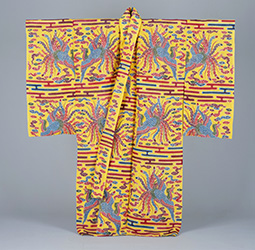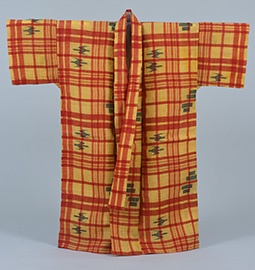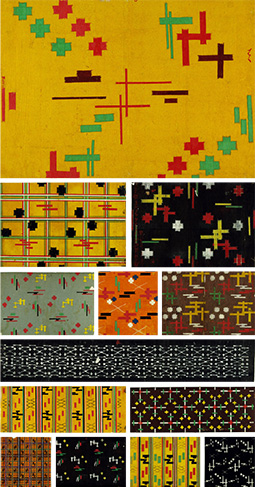December 2022
- English
- 日本語
The Textile Patterns of Okinawa

Ryusou (Okinawan kimono) made with bingata textile dyed with a motif of flowing water and different colored maple leaves (National Treasure: Ryukyu King Sho Family Related Documents) 
Ryusou (Okinawan kimono) made with bingata textile dyed with phoenix and mist patterns (National Treasure: Ryukyu King Sho Family Related Documents) 
A costume with a Ryukyu kasuri motif and woven checkered pattern (National Treasure: Ryukyu King Sho Family Related Documents) 
Sections of various miezu patterns (Album of Miezu Pattern Samples (National Treasure: Ryukyu King Sho Family Related Documents))

Okinawa, formerly the Ryukyu Kingdom, once prospered through its central role in the maritime trade networks of East and Southeast Asia. Okinawa has thus been culturally influenced by various countries as may be seen in its distinctive patterns.

This year (2022), Okinawa Prefecture is celebrating the 50th anniversary of its return to Japan after World War II. Located in Japan’s far South West, Okinawa is made up of more than 150 large and small islands and has a subtropical marine climate. Actually, Okinawa once prospered through trade with the countries of East and Southeast Asia, being situated at the center of the region’s network of maritime trade routes.
In the age when Okinawa was known as the Ryukyu Kingdom (1429–1879), the kingdom’s government was located in Shuri Castle* in the capital, Shuri (now Naha City). The town along the coast called Naha at that time developed as a trading and commercial center connecting the capital to foreign countries. The cultural development of the Ryukyu Kingdom was influenced by many countries through this trade.
During its heyday, the cornerstone of the kingdom’s economy was the craft products that were exported to other countries, and a variety of designs, including patterns, were managed with great detail at a department specializing in the production of lacquer crafts set up by the royal government.
Yamada Yoko, curator at the Naha City Museum of History, says that “the patterns used in craft products were designed to please those receiving them, with artists in the royal government’s design department sometimes researching the preferences of importing countries.”
Since the times of the Ryukyu Kingdom, there have been special Okinawan dyed fabrics known as bingata, created using a resist dyeing technique** of the same name. The patterns used for these textiles can be divided into two broad categories: patterns brought from China and those that developed from traditional Japanese patterns. Certain patterns brought from China such as dragons and phoenixes were used as symbols of royal authority in the Ryukyu Kingdom. At the same time, the plants often used as motifs in bingata, including cherry and plum blossoms, Japanese irises and maple leaves, do not grow naturally in Okinawa, and are clearly influenced by the traditional patterns of Japan.
The reason why the finished products have an Okinawan feel despite their use of motifs from outside Okinawa is their use of color.
Yamada says, “A characteristic of bingata is the extreme brightness of the colors. They are incredibly vivid and bright. Ryukyu aesthetics are clearly expressed here.”
On the other hand, uniquely Okinawan pattern designs can be seen in woven kasuri textiles. Kasuri textiles use differently colored dyed threads in sections to produce a pattern. This technique is thought to have originated in India, been brought to the Ryukyu Kingdom via Southeast Asian countries, and from there spread across Japan.

Many miezu (design patterns) for kasuri are recorded in miezu-cho albums that were created in the days of the Ryukyu Kingdom. It is thought that high-ranking people including members of the royal family referred to the miezu-cho when ordering their kasuri fabrics and decided on designs. There are said to have been more than 600 miezu patterns created in total, with the Naha City Museum of History in possession of albums containing 366 of them.

It is thought that the weavers of the time gave kasuri names associated with the pattern's shape, and these patterns and names have remained familiar to the public to this day. For example, tuiguwaa, depicting flying birds; ichichimaru gumu, depicting five round clouds; and in-nu-fisaa, representing dog footprints, are patterns that are instantly recognizable as “Ryukyu kasuri.”
The various patterns such as those on bingata developed from repeated interactions through international trade, while kasuri patterns have a distinctly Okinawan provenance. These Okinawan patterns reflect the diversity of Okinawan sensibilities, which developed through the island people’s exposure to many different cultures.

- * Built in the middle of the 14th century. It is said that Sho Hashi (the first king of the Ryukyu Kingdom) made the castle his base of operations in 1429. Thereafter, it was used as a royal castle for around 450 years. It was destroyed by fire in World War II in 1945, and the current fortress was rebuilt in 1992. The main hall was destroyed by fire in 2019, and restoration work is currently ongoing.
- ** A dyeing technique that uses stencils. The pattern is placed on a white fabric, anti-staining glue is applied on top, and after drying the entire fabric is dyed with pigment, then steamed and washed. Only the areas applied with anti-staining glue are left white.

